-
 Effect of Heat Treatments and Related Microstructural Modifications on High-Cycle Fatigue Behavior of Powder Bed Fusion–Laser Beam-Fabricated Ti-6Al-2Sn-4Zr-6Mo Alloy
Effect of Heat Treatments and Related Microstructural Modifications on High-Cycle Fatigue Behavior of Powder Bed Fusion–Laser Beam-Fabricated Ti-6Al-2Sn-4Zr-6Mo Alloy -
 Point Defects in MoNbTi-Based Refractory Multi-Principal-Element Alloys
Point Defects in MoNbTi-Based Refractory Multi-Principal-Element Alloys -
 Residual Stress and Corrosion Performance in L-PBF Ti6Al4V: Unveiling the Optimum Stress Relieving Temperature via Microcapillary Electrochemical Characterisation
Residual Stress and Corrosion Performance in L-PBF Ti6Al4V: Unveiling the Optimum Stress Relieving Temperature via Microcapillary Electrochemical Characterisation -
 The Effect of Mo and Al Substitution in Cryomilled and Cold-Rolled FeNi Alloys
The Effect of Mo and Al Substitution in Cryomilled and Cold-Rolled FeNi Alloys
Journal Description
Metals
Metals
is an international, peer-reviewed, open access journal published monthly online by MDPI. The Portuguese Society of Materials (SPM), and the Spanish Materials Society (SOCIEMAT) are affiliated with Metals and their members receive discounts on the article processing charges.
- Open Access— free for readers, with article processing charges (APC) paid by authors or their institutions.
- High Visibility: indexed within Scopus, SCIE (Web of Science), Inspec, Ei Compendex, CAPlus / SciFinder, and other databases.
- Journal Rank: JCR - Q2 (Metallurgy and Metallurgical Engineering) / CiteScore - Q1 (Metals and Alloys)
- Rapid Publication: manuscripts are peer-reviewed and a first decision is provided to authors approximately 18 days after submission; acceptance to publication is undertaken in 2.6 days (median values for papers published in this journal in the first half of 2025).
- Recognition of Reviewers: reviewers who provide timely, thorough peer-review reports receive vouchers entitling them to a discount on the APC of their next publication in any MDPI journal, in appreciation of the work done.
- Companion journals for Metals include: Compounds and Alloys.
Impact Factor:
2.5 (2024);
5-Year Impact Factor:
2.8 (2024)
Latest Articles
Soft Magnetic Nanocrystalline FeSiBCuCa Alloys with High Electric Resistivity
Metals 2026, 16(1), 11; https://doi.org/10.3390/met16010011 - 21 Dec 2025
Abstract
Here, we report a soft magnetic nanocrystalline alloy with high electric resistivity (ρ) up to 221 μΩ·cm. The (Fe82Si3B14Cu1)100−xCax (x = 0, 0.12, 0.36, and 0.6) alloys were prepared by
[...] Read more.
Here, we report a soft magnetic nanocrystalline alloy with high electric resistivity (ρ) up to 221 μΩ·cm. The (Fe82Si3B14Cu1)100−xCax (x = 0, 0.12, 0.36, and 0.6) alloys were prepared by melt spinning. The effects of Ca addition and annealing treatment on the microstructure and properties of the alloys have been investigated. It was found that Fe82Si3B14Cu1 alloys without Ca doping contain mainly one nanocrystalline phase of α-Fe, but both α-Fe and Fe3B nanophases coexist in the as-prepared alloys with relatively high Ca contents (x = 0.36 and 0.6) and annealed Ca co-doped alloys. The presence of Fe3B nano-crystals leads to high resistivity without significantly reducing the soft magnetic properties. The saturated magnetic induction Bs of (Fe82Si3B14Cu1)100−xCax (x = 0, 0.12, 0.36, and 0.6) alloys ranges from 1.75 T to 1.80 T, and the coercivity Hc of annealed alloys shows a tendency to increase with an increase in Ca content. Meanwhile, the resistivity of both as-prepared and annealed alloys increases with increasing Ca content. The as-prepared (Fe82Si3B14Cu1)99.4Ca0.6 alloy exhibits an excellent combination of soft magnetic properties with ρ = 221 μΩ·cm, Hc = 20.3 A/m, and Bs = 1.57 T. After annealing, these values changed to 158 μΩ·cm, 21.6 A/m, and 1.79 T, respectively. We believe that this work is helpful for developing nanocrystalline soft magnetic alloys for high-frequency applications.
Full article
(This article belongs to the Section Metallic Functional Materials)
Open AccessArticle
LPBF Parameter Optimization of Mechanical, Non-Thermal Generated C71500 Powder
by
Andrew Sparrow, Walter Smith and Troy Ansell
Metals 2026, 16(1), 10; https://doi.org/10.3390/met16010010 - 21 Dec 2025
Abstract
This work investigates the optimization of Laser Powder Bed Fusion (LPBF) parameters for the C71500 copper-nickel alloy using mechanically produced, non-thermally generated powder. Utilization of this powder presents a more sustainable powder generation method through significant reduction in energy usage and CO2
[...] Read more.
This work investigates the optimization of Laser Powder Bed Fusion (LPBF) parameters for the C71500 copper-nickel alloy using mechanically produced, non-thermally generated powder. Utilization of this powder presents a more sustainable powder generation method through significant reduction in energy usage and CO2 emissions and a large array of alloys to be utilized within LPBF. A comprehensive design of experiments (DOE), with varying laser power and scan speed, was employed to construct a process performance map, which was subsequently refined using machine learning algorithms. Specimens fabricated under optimized conditions exhibited high dimensional fidelity, low surface roughness and porosity, and achieved relatively dense specimens. Mechanical testing confirmed that the optimized parameter sets exceeded standard wrought alloy values for ultimate tensile strength and yield strength, with almost meeting standard cast alloy values demonstrating feasibility of implementing common bar stock alloys in LPBF applications. The observed variability in tensile properties was attributed to inefficient laser parameters requiring further optimization. Future efforts will focus on repeating the optimization using quality powder controls and further refining tensile performance within the high-density region of the parameter space.
Full article
(This article belongs to the Section Additive Manufacturing)
►▼
Show Figures
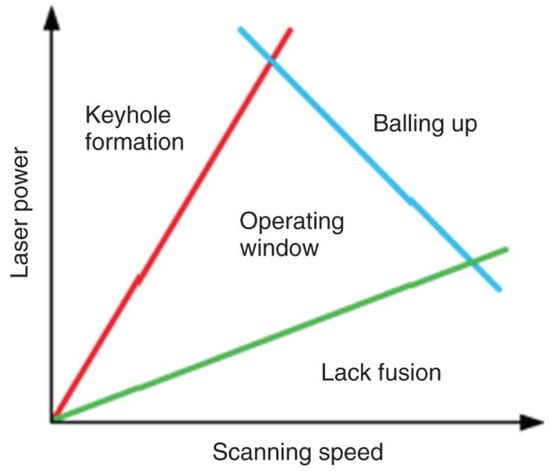
Figure 1
Open AccessArticle
Enhancement of the Wear Properties of Tool Steels Through Gas Nitriding and S-Phase Coatings
by
Sebastian Fryska, Mateusz Wypych, Paweł Kochmański and Jolanta Baranowska
Metals 2026, 16(1), 9; https://doi.org/10.3390/met16010009 (registering DOI) - 21 Dec 2025
Abstract
Tool steels are critical for high-load applications, e.g., forging and metal-forming, where they face thermal cracking, fatigue, erosion, and wear. This study evaluates the impact of gas nitriding and S-phase PVD coatings on the mechanical and tribological properties of four tool steels: 40CrMnNiMo8-6-4,
[...] Read more.
Tool steels are critical for high-load applications, e.g., forging and metal-forming, where they face thermal cracking, fatigue, erosion, and wear. This study evaluates the impact of gas nitriding and S-phase PVD coatings on the mechanical and tribological properties of four tool steels: 40CrMnNiMo8-6-4, 60CrMoV18-5, X50CrMoV5-2, and X38CrMoV5-3. Samples were heat-treated (quenched and tempered at 600 °C), then gas-nitrided at 575 °C for 6 h with nitriding potentials (Kn) of 0.18, 0.79, or 2.18, or coated via reactive magnetron sputtering in Ar/N2 or Ar/N2/CH4 atmospheres at 200 °C or 400 °C. Characterization involved XRD, LOM, FE-SEM, GDOES, Vickers hardness (HV0.1), and ball-on-disk wear testing with Al2O3_ counter-samples. Gas nitriding produced nitrogen diffusion layers (80–200 μm thick) and compound layers (ε-Fe(2-3)N, γ’-Fe4N) at higher Kn, increasing hardness by 80–100% (up to 1100 HV0.1 for steel X38CrMoV5-3). S-phase coatings (1.6–3.6 μm thick) formed expanded austenite with varying N content, achieving comparable hardness (up to 1100 HV0.1) in high-N2 atmospheres, alongside substrate diffusion layers. Both types of treatment enhance load-bearing capacity, adhesion, and durability, offering superior wear resistance compared to conventional PVD coatings and addressing demands for extended tool life in industrial applications.
Full article
(This article belongs to the Special Issue Surface Treatments and Coating of Metallic Materials (2nd Edition))
►▼
Show Figures

Figure 1
Open AccessArticle
Multilevel Prediction of Mechanical Properties of Samples Additively Manufactured from Steel 308LSi
by
Nikita Kondratev, Andrey Podsedertsev, Dmitry Bezverkhy, Elvira Sharifullina, Tatyana Olshanskaya and Dmitry Trushnikov
Metals 2026, 16(1), 8; https://doi.org/10.3390/met16010008 (registering DOI) - 21 Dec 2025
Abstract
This study employs a multilevel modeling approach to describe the deformation of specimens made from austenitic Wire Arc Additive Manufactured (WAAM) steel 308LSi. Two WAAM processing modes were investigated: (1) the Cold Metal Transfer (CMT) method and (2) Cold Metal Transfer combined with
[...] Read more.
This study employs a multilevel modeling approach to describe the deformation of specimens made from austenitic Wire Arc Additive Manufactured (WAAM) steel 308LSi. Two WAAM processing modes were investigated: (1) the Cold Metal Transfer (CMT) method and (2) Cold Metal Transfer combined with interlayer deformation strengthening (hammer peening/forging). Test specimens were cut from the deposited walls at 0° and 90° relative to the deposition direction. The grain and dendritic structures of the specimens were analyzed using optical stereomicroscopy. A statistical multilevel model has been developed, accounting for the features of the grain-dendritic and defect structures under various technological deposition modes. Parameter identification and model verification were conducted based on experimental data from uniaxial tensile tests of 308LSi steel specimens. The maximum deviation of the numerical results from the experimental data during the identification stage under uniaxial tensile loading did not exceed 3%, and during the verification stage it did not exceed 10%; the overall mean deviation did not exceed 1% for the identification stage and 2% for the verification stage. The model effectively captured the anisotropic mechanical behavior of WAAM-processed samples. The maximum calculated yield strength 360 MPa was obtained for specimens cut at an angle of 45°, while the minimum value 331 MPa was observed for vertically oriented specimens. Specimens subjected to interlayer forging (hammer peening) exhibited isotropic material properties. Explicit multilevel modeling, incorporating the presence of MnO oxide inclusions located within the austenite matrix, was performed. The results showed good correlation with experimental data and confirmed the localization of fatigue cracks at the phase boundary-matrix-oxide interface.
Full article
(This article belongs to the Special Issue Deformation Behavior and Microstructure Evolution of Alloys)
Open AccessArticle
A New Methodology for Determining the Friction Factor
by
Sergei Alexandrov, Dragisa Vilotic, Marina Rynkovskaya, Yong Li, Nemanja Dacevic and Marko Vilotic
Metals 2026, 16(1), 7; https://doi.org/10.3390/met16010007 (registering DOI) - 20 Dec 2025
Abstract
The friction law, which requires that the friction stress is a constant fraction of the local yield shear stress, is widely used for modeling bulk metal forming processes. Determining the friction factor involved in this friction law requires an experiment and its theoretical
[...] Read more.
The friction law, which requires that the friction stress is a constant fraction of the local yield shear stress, is widely used for modeling bulk metal forming processes. Determining the friction factor involved in this friction law requires an experiment and its theoretical description. It is advantageous if the latter is not based on the finite element or similar methods, since the friction factor is unknown prior to the calculation. The present paper suggests using a plane strain compression test. The experimental setup is slightly more complicated than the standard ring compression test. However, its advantage lies in the availability of relatively simple and accurate theoretical solutions for a broad class of constitutive equations, which overcomes the experimental disadvantage. The present paper is limited to isotropic strain-hardening materials. The experimental research is conducted on aluminum alloy AA 6026 and steel C45. The friction factor is determined for three types of lubricant.
Full article
(This article belongs to the Special Issue Theory, Simulation, and Process of Metal Forming)
►▼
Show Figures
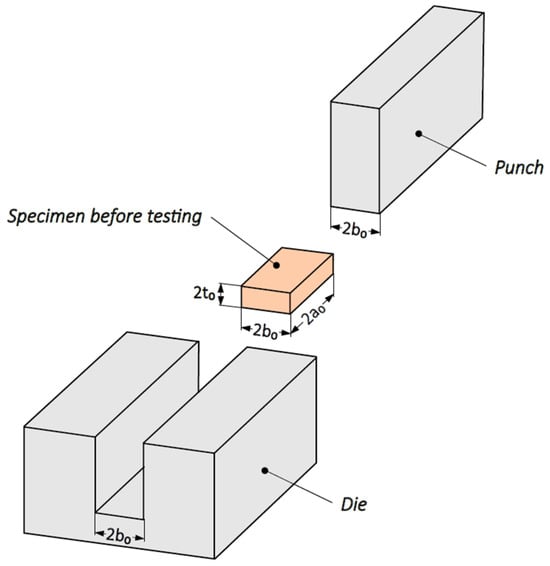
Figure 1
Open AccessArticle
Structure and Properties of Stainless Steel–Thermoplastic Joints Made Using Resistance Element Soldering Technology
by
Pavol Sejč, Pavol Švec, Peter Gogola, Branislav Vanko, Zuzana Gábrišová, Alexander Schrek and Miroslav Zelina
Metals 2026, 16(1), 6; https://doi.org/10.3390/met16010006 (registering DOI) - 20 Dec 2025
Abstract
This study investigated the microstructure and properties of soldered joints of AISI 304 stainless steel and PMMA thermoplastic or AW-1050A aluminum alloys made using Resistance Element Soldering (RES) technology. The bimetallic element used in RES provided a mechanical joint with a thermoplastic or
[...] Read more.
This study investigated the microstructure and properties of soldered joints of AISI 304 stainless steel and PMMA thermoplastic or AW-1050A aluminum alloys made using Resistance Element Soldering (RES) technology. The bimetallic element used in RES provided a mechanical joint with a thermoplastic or aluminum alloy and a soldered joint with AISI 304 steel using Sn60Pb40 solder in the core of the element. The solder in combination with the Chemet CHM-A-014 flux wetted the AISI 304 steel surface very well at a temperature of 225 °C with a contact angle of 14°. During the production of the joints, the solder melted in the bimetallic element on the AISI 304 steel side, while solid solder was retained at the point of contact with the welding electrode. The strength of the joints ranged from 25.5 to 36.4 MPa, which was less than the strength of the solder, and the joints failed at the AISI 304 steel–Sn60Pb40 solder interface. The fracture surface was predominantly formed by the solder. An intermetallic phase of FeSn2 was identified at the interface.
Full article
(This article belongs to the Special Issue Novel Insights into Welding and Joining Technologies of Metallic Materials)
►▼
Show Figures
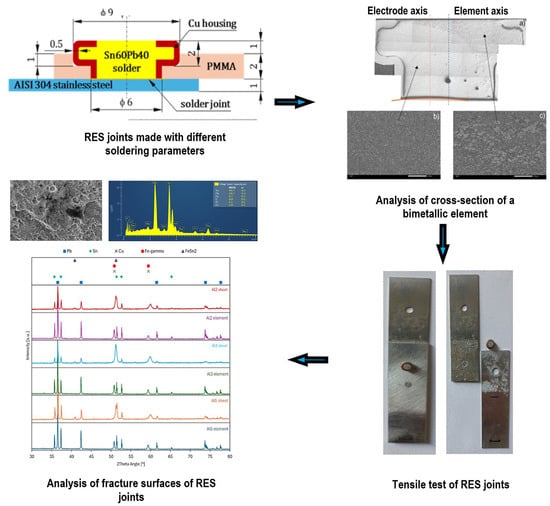
Graphical abstract
Open AccessArticle
Highly Printable Fe3Al Intermetallic Alloy
by
Aliakbar Emdadi, Yitong Yang, Joanna Szyndler, Felix Jensch, Gökhan Ertugrul, Michael Tovar, Sebastian Härtel and Sabine Weiß
Metals 2026, 16(1), 5; https://doi.org/10.3390/met16010005 (registering DOI) - 20 Dec 2025
Abstract
Intermetallic Fe3Al-based alloys reinforced with Laves-phase precipitates are emerging as potential replacements for conventional high-alloy steels and possibly polycrystalline Ni-based superalloys in structural applications up to 700 °C. Their impressive mechanical properties, however, are offset by limited fabricability and poor machinability
[...] Read more.
Intermetallic Fe3Al-based alloys reinforced with Laves-phase precipitates are emerging as potential replacements for conventional high-alloy steels and possibly polycrystalline Ni-based superalloys in structural applications up to 700 °C. Their impressive mechanical properties, however, are offset by limited fabricability and poor machinability due to their severe brittleness. High tool wear during finish-machining, which is still required for components such as turbine blades, remains a key barrier to their broader adoption. In contrast to conventional manufacturing routes, additive manufacturing offers a viable solution by enabling near-net-shape manufacturing of difficult-to-machine iron aluminides. In the present study, laser powder bed fusion was used to produce an Fe-25Al-1.5Ta intermetallic containing strengthening Laves-phase precipitates, and the porosity, microstructure and phase composition were characterized as a function of the process parameters. The results showed that preheating the build plate to 650 °C effectively suppressed delamination and macrocrack formation, even though noticeable cracking still occurred at the high scan speed of 1000 mm/s. X-ray tomography revealed that samples fabricated with a lower scan speed (500 mm/s) and a higher layer thickness (0.1 mm) contained larger, irregularly shaped pores, whereas specimens printed at the same volumetric energy density (40 J/mm3) but with different parameter sets exhibited smaller fractions of predominantly spherical pores. All samples contained mostly elongated grains that were either oriented close to <001> relative to the build direction or largely texture-free. X-ray diffraction confirmed the presence of Fe3Al and C14-type (Fe, Al)2Ta Laves phase in all samples. Hardness values fell within a narrow range (378–398 HV10), with only a slight reduction in the specimen exhibiting higher porosity.
Full article
(This article belongs to the Special Issue Additive Manufacturing of High-Temperature Metallic Materials and Intermetallics)
►▼
Show Figures

Figure 1
Open AccessArticle
Optimization of T6 Heat Treatment for Enhanced Microstructural Stability and Mechanical Properties of EV31A Magnesium Alloy
by
Jingya Cui, Yao Li, Tong Mu, Xiushen Ye, Lingyun An, Daogui Lai, Chushan Yi and Honghui Liu
Metals 2026, 16(1), 4; https://doi.org/10.3390/met16010004 (registering DOI) - 19 Dec 2025
Abstract
This study systematically optimizes the T6 heat treatment of a commercial EV31A magnesium alloy and evaluates the resulting microstructural evolution and mechanical properties. Optical microscopy, scanning electron microscopy combined with energy-dispersive X-ray spectroscopy (SEM-EDS), X-ray diffraction (XRD), and transmission electron microscopy (TEM) were
[...] Read more.
This study systematically optimizes the T6 heat treatment of a commercial EV31A magnesium alloy and evaluates the resulting microstructural evolution and mechanical properties. Optical microscopy, scanning electron microscopy combined with energy-dispersive X-ray spectroscopy (SEM-EDS), X-ray diffraction (XRD), and transmission electron microscopy (TEM) were used to characterize the microstructure and phase constitution, while differential scanning calorimetry (DSC) was employed to determine appropriate solution treatment parameters. Brinell hardness measurements and tensile tests at room temperature and 150 °C were carried out to quantify the mechanical response. The as-cast alloy consists of α-Mg equiaxed grains, bone-shaped Mg12(Nd,Gd) eutectic phases at grain boundaries, and minor intragranular lath-shaped Mg12Nd phases. After T6 treatment (520 °C/10 h solution treatment + 200 °C/16 h aging), the grain boundary eutectic phases partially dissolve and transform into Mg41(Nd,Gd)5, while intragranular nano-scale β′ precipitates and stable Zn2Zr3 particles form, achieving multi-scale synergistic strengthening. Compared to the as-cast condition, the T6-treated alloy exhibits room-temperature ultimate tensile strength and yield strength of 309 ± 40.5 MPa (31% increase) and 180 ± 14.2MPa (45% increase), respectively. At 150 °C, the strength reaches 241 ± 7.5 MPa (39% increase) and 154 ± 16.8 MPa (52% increase), while maintaining an elongation of 10.9± 0.7%, demonstrating an excellent strength–ductility balance.
Full article
(This article belongs to the Special Issue Forming and Processing Technologies of Lightweight Metal Materials)
►▼
Show Figures
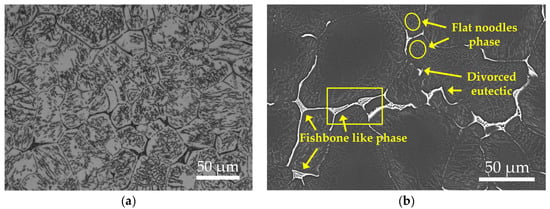
Figure 1
Open AccessArticle
Study on the Recrystallization Behavior and Texture Evolution of 0.5 mm Electromagnetic Pure Iron Cold-Rolled Strip
by
Qing Li, Huaying Li, Yinghui Wei, Yipu Shi, Baosheng Liu and Yong Jiang
Metals 2026, 16(1), 3; https://doi.org/10.3390/met16010003 - 19 Dec 2025
Abstract
The control of recrystallization in submillimeter-gauge electromagnetic pure iron strips is critical for developing high-sensitivity electromagnetic devices, yet the microstructure–property relationship during annealing remains poorly understood. This study systematically investigates the recrystallization topology, texture evolution, and their direct links to the electromagnetic properties
[...] Read more.
The control of recrystallization in submillimeter-gauge electromagnetic pure iron strips is critical for developing high-sensitivity electromagnetic devices, yet the microstructure–property relationship during annealing remains poorly understood. This study systematically investigates the recrystallization topology, texture evolution, and their direct links to the electromagnetic properties in an industrially produced 0.5 mm thick DT4 electromagnetic pure iron cold-rolled strip (80% reduction) during annealing at 900 °C. By combining EBSD, XRD, and VSM, we found that recrystallization initiates at shear bands after 7 s and completes within 25 s, yielding equiaxed grains with an average size of 27.5 μm. Prolonged annealing to 180 s led to grain coarsening to 64 μm. Concurrently, the fraction of low-angle grain boundaries decreased dramatically from 69.6% to 9.09%. The recrystallization texture, dominated by oriented nucleation at shear bands, showed a stable γ-fiber component (~20% volume fraction) and a significantly attenuated α-fiber component (decreasing from 66.3% to 21.5%). The Goss texture ({110}<001>) increased notably from 0.54% to 14.0%, attributable to grain boundary energy minimization in the later stages. Recrystallization kinetics obeyed the JMAK model Xrex = 1 − exp (−2.29 × 10−8 t6.434). Crucially, the completed recrystallization process reduced the coercivity (Hc) by 78.5% and increased the magnetic induction B10000 by 0.045T. These findings elucidate the recrystallization mechanism and establish a quantitative microstructure–property correlation, providing a theoretical foundation for optimizing industrial annealing processes for thin-gauge electromagnetic pure iron strips.
Full article
(This article belongs to the Special Issue Advanced Rolling Technologies of Steels and Alloys)
►▼
Show Figures
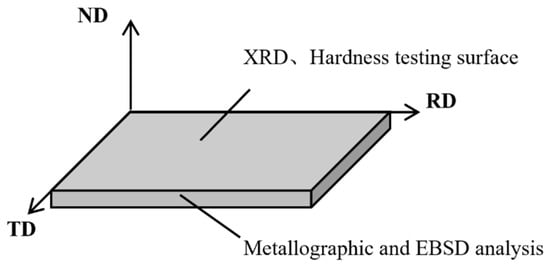
Figure 1
Open AccessReview
Structural Performance of Semi-Rigid Beam-to-Column Connections in Steel Storage Racks: A Review Focused on FEM Analysis
by
Mirjana Piskulic, Rodoljub Vujanac, Snezana Vulović, Nenad Miloradovic, Mirko Blagojevic and Zorica Djordjevic
Metals 2026, 16(1), 2; https://doi.org/10.3390/met16010002 - 19 Dec 2025
Abstract
In practical applications, steel storage racks include a wide range of beam-to-column connections (BCCs), which have a significant impact on their structural stability, particularly under various loading conditions. This systematic review focuses on the application of the finite element method (FEM) as a
[...] Read more.
In practical applications, steel storage racks include a wide range of beam-to-column connections (BCCs), which have a significant impact on their structural stability, particularly under various loading conditions. This systematic review focuses on the application of the finite element method (FEM) as a complementary tool to evaluate the mechanical behavior of these connections. Key parameters that influence connection performance include the connector’s class and hook configuration, column thickness, beam height and weld position on the connector. Although the Eurocode 3 standard provides design guidelines for connections, experimental testing remains the most reliable method due to the complexity of semi-rigid connections, particularly in the context of pallet racks. Validated FEM analysis emerges as a dependable and cost-effective alternative to experiments, enabling more detailed parametric studies and improving the prediction of structural response. This review focuses on the advantages of FEM integration into design workflows via quantitative synthesis, while also emphasizing the role of contact formulations in modeling accuracy. To establish FEM as an independent predictive tool for the design and optimization of steel storage racks, future research should focus on cohesive zone modeling, ductile damage criteria, advanced contact strategies and additional machine learning (ML) techniques.
Full article
(This article belongs to the Special Issue Numerical and Experimental Advances in Metal Processing)
►▼
Show Figures

Figure 1
Open AccessArticle
Assessment of the Influence of Specimen Size on the Performance of CLF-1 Steel Based on the GTN Model
by
Xiang Ruan, Zhanze Shi, Bintao Yu, Bing Bai, Xinfu He, Changyi Zhang and Wen Yang
Metals 2026, 16(1), 1; https://doi.org/10.3390/met16010001 - 19 Dec 2025
Abstract
Irradiation embrittlement occurs in the cladding materials of fusion reactors during irradiation. Determining the ductile–brittle transition temperature via Charpy impact testing is the primary method for evaluating irradiation embrittlement. Standard-sized V-shaped Charpy impact specimens (CVN) are too large in size and have high
[...] Read more.
Irradiation embrittlement occurs in the cladding materials of fusion reactors during irradiation. Determining the ductile–brittle transition temperature via Charpy impact testing is the primary method for evaluating irradiation embrittlement. Standard-sized V-shaped Charpy impact specimens (CVN) are too large in size and have high induced radioactivity. Small-sized specimens (KLST) can solve these problems, but the performance data measured from small-sized specimens are different from those of standard specimens. In other words, there is a size effect in impact performance. The notch size and hammer impact speed of KLST specimens are different from those of CVN specimens. The influence of these factors on impact performance requires further study. In response to these issues, on the basis of the previous experiments conducted by the research group, GTN damage models of CVN specimens and KLST specimens are constructed using the inverse operation method. Numerical simulation of the impact on the upper platform area is carried out for KLST specimens and variable-sized KLST specimens. Compared with the test results, the numerical simulation results are in good agreement, verifying the accuracy and reliability of the model. The results show that the notch angle and radius have little influence on the plastic zone. The cross-sectional area of the notch has a significant impact on the plastic zone. The impact velocity within the range of 3.8 m/s to 5.24 m/s affects the impact response process, but does not affect the load–displacement curve, the length of the non-plastic deformation zone, or the volume of the plastic zone.
Full article
(This article belongs to the Special Issue Fracture Mechanics and Failure Analysis of Metallic Materials)
►▼
Show Figures

Figure 1
Open AccessArticle
Influence of Surface Finishing on the Corrosion and Wear Behaviour of AISI 304 and AISI 436 Stainless Steels
by
Silvia Gómez, Ismael Lamas, Alejandro Pereira and M. Consuelo Pérez
Metals 2025, 15(12), 1390; https://doi.org/10.3390/met15121390 - 18 Dec 2025
Abstract
The pitting corrosion resistance and the tribological behaviour of a ferritic stainless steel with high Mo content (AISI 436) and a commonly employed austenitic stainless steel (AISI 304) are compared. Special attention was paid to the role of Mo in improving corrosion resistance
[...] Read more.
The pitting corrosion resistance and the tribological behaviour of a ferritic stainless steel with high Mo content (AISI 436) and a commonly employed austenitic stainless steel (AISI 304) are compared. Special attention was paid to the role of Mo in improving corrosion resistance of ferritic stainless steels. Since the surface condition is an important parameter related to the onset of pitting corrosion in the presence of chlorides, three different surface finishes were tested for both steels. Two commercial finishing grades and laboratory polishing down to 1 µm were compared. Moreover, the influence of surface condition on the tribological properties for both steels was also evaluated. The study demonstrates that surface finishing plays a decisive role in both the electrochemical and mechanical response of stainless steels. A comprehensive microstructural and tribological analysis reveals not only how commercial finishing treatments modify passive film behaviour, but also how they affect friction stability and wear mechanisms. Special emphasis is placed on the synergistic effect between molybdenum content, passive film integrity and manufacturing processes. The obtained results provide valuable insight for industrial applications where durability against chloride exposure and abrasion is critical.
Full article
(This article belongs to the Special Issue Corrosion Behavior of Carbon Steels in Natural and Industrial Environments—3rd Edition)
►▼
Show Figures

Figure 1
Open AccessArticle
An Experimental Investigation of the Influence of Deposition Power and Pressure on the Anti-Icing and Wettability Properties of Al-Doped ZnO Thin Films Prepared by Magnetron Sputtering
by
Vandan Vyas, Kamlesh V. Chauhan, Sushant Rawal and Noor Mohammad Mohammad
Metals 2025, 15(12), 1389; https://doi.org/10.3390/met15121389 - 18 Dec 2025
Abstract
In the presented research, aluminum-doped zinc oxide (AZO) thin films were synthesized on high-power transmission lines using the RF magnetron sputtering process. The impact of deposition power (160 W to 280 W) and deposition pressure (2 Pa to 5 Pa), on key characteristics
[...] Read more.
In the presented research, aluminum-doped zinc oxide (AZO) thin films were synthesized on high-power transmission lines using the RF magnetron sputtering process. The impact of deposition power (160 W to 280 W) and deposition pressure (2 Pa to 5 Pa), on key characteristics like material composition, wettability, anti-icing behavior, and average crystal size were analyzed. The optimization of wettability and anti-icing performance was carried out using two-factor, four-level design of the Taguchi method to study the combined effects of multiple parameters rather than the effect of a single parameter. Considerable variation in the water contact angle, from 92.3° to 123.6°, has been observed, suggesting an enhancement in hydrophobic nature with optimized condition. Anti-icing tests demonstrated that the coated surface delayed ice accumulation by approximately 4.56 times compared to the uncoated surface. X-ray diffraction (XRD) analysis was carried out to confirm notable changes in the intensity of the (002) peak along the c-axis, directly correlating with grain size modification. The change in surface roughness was studied using AFM and the results were compared to establish a relationship between surface roughness and average grain size. Overall, the findings highlight the critical role of deposition parameters and their interactions in modifying the surface and structural properties of AZO thin films, which demonstrates their potential application for improving the anti-icing performance of transmission lines.
Full article
(This article belongs to the Special Issue Surface Treatments and Coating of Metallic Materials)
►▼
Show Figures
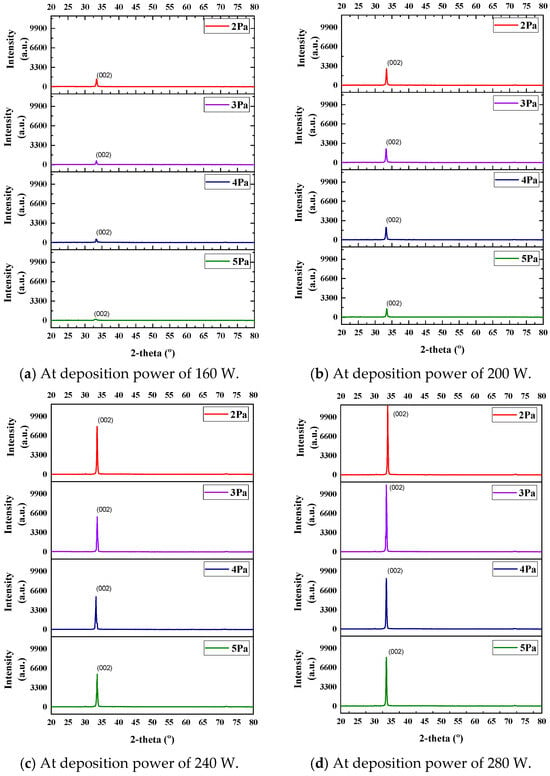
Figure 1
Open AccessArticle
Optimization of a Center-Punching Mechanical Clinching Process for High-Strength Steel DP980 and Aluminum Alloy AL5052 Sheets
by
Ping Qiu, Xiaoxin Lu, Boran Deng, Hong Xiao and Chao Yu
Metals 2025, 15(12), 1388; https://doi.org/10.3390/met15121388 - 18 Dec 2025
Abstract
As research on new, lightweight energy vehicles continues to develop, the application of high-strength steel sheets with tensile strength greater than 1 GPa and their mechanical clinching technology, which is associated with aluminum alloys, has emerged as a new research focus. However, due
[...] Read more.
As research on new, lightweight energy vehicles continues to develop, the application of high-strength steel sheets with tensile strength greater than 1 GPa and their mechanical clinching technology, which is associated with aluminum alloys, has emerged as a new research focus. However, due to the challenges associated with the cold deformation of high-strength steel, conventional mechanical clinching processes often fail to establish effective joint interlocking, resulting in weak connections. This study proposes a center-punching mechanical clinching process for connecting DP980 high-strength steel to AL5052 aluminum alloy. The mechanical evolution during the forming process was analyzed via finite element simulation. An orthogonal experimental design was employed to optimize key geometric parameters of the punch and die, yielding the optimal configuration for the mold. Mechanical testing of the joint demonstrated average pull-out force and pull-shear forces of 1124 N and 2179 N, respectively, confirming the proposed process’s ability to successfully connect high-strength steel and aluminum alloy.
Full article
(This article belongs to the Special Issue Manufacturing Processes of Metallic Materials (2nd Edition))
►▼
Show Figures
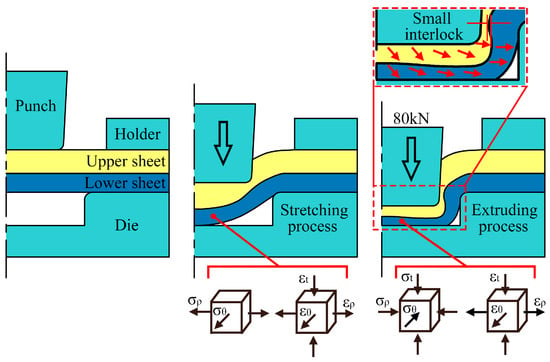
Figure 1
Open AccessArticle
Corrosion Behavior upon Laser Surface Texturing AISI 430 Stainless Steel
by
Edit Roxana Moldovan, Liana Sanda Baltes, Catalin Croitoru, Alexandru Pascu and Mircea Horia Tierean
Metals 2025, 15(12), 1387; https://doi.org/10.3390/met15121387 - 18 Dec 2025
Abstract
Laser surface texturing (LST) is an effective method for enhancing surface functionality, but its effect on corrosion resistance highly depends on texture design and processing parameters. This study investigates the influence of two LST patterns—orthogonal ellipses and concentric octo-donuts—applied with 1 to 20
[...] Read more.
Laser surface texturing (LST) is an effective method for enhancing surface functionality, but its effect on corrosion resistance highly depends on texture design and processing parameters. This study investigates the influence of two LST patterns—orthogonal ellipses and concentric octo-donuts—applied with 1 to 20 repetitions on the corrosion resistance of AISI 430 ferritic stainless steel. Corrosion behavior was evaluated using potentiodynamic polarization in a 3.5 wt.% NaCl solution at room temperature, complemented by SEM and EDS analysis. The results indicate that while a single laser pass can maintain good corrosion resistance, increasing the number of repetitions significantly degrades performance. This is attributed to the disruption of the protective oxide layer, the introduction of residual stress, and the creation of localized sites for galvanic corrosion. Consequently, the study concludes that a low number of laser repetitions is crucial for preserving the corrosion resistance of LST-processed AISI 430 steel.
Full article
(This article belongs to the Special Issue Surface Treatments and Coating of Metallic Materials)
►▼
Show Figures

Figure 1
Open AccessArticle
Multiple Diffraction in a Basic Co-Rich Decagonal Al-Co-Ni Quasicrystal
by
Changzeng Fan
Metals 2025, 15(12), 1386; https://doi.org/10.3390/met15121386 - 18 Dec 2025
Abstract
To reveal its influence on quasicrystal structure analysis, multiple diffraction effects in a basic Co-rich decagonal Al-Co-Ni quasicrystal have been investigated in-house and with synchrotron radiation. Two weak reflections were chosen as the main reflections in the in-house measurements, and 40°
To reveal its influence on quasicrystal structure analysis, multiple diffraction effects in a basic Co-rich decagonal Al-Co-Ni quasicrystal have been investigated in-house and with synchrotron radiation. Two weak reflections were chosen as the main reflections in the in-house measurements, and 40°
(This article belongs to the Special Issue Research Progress of Crystal in Metallic Materials)
►▼
Show Figures

Figure 1
Open AccessArticle
Effect of Solidification Conditions on High-Cycle Fatigue Behavior in DD6 Single-Crystal Superalloy
by
Hongji Xie, Yushi Luo, Yunsong Zhao and Zhenyu Yang
Metals 2025, 15(12), 1385; https://doi.org/10.3390/met15121385 - 17 Dec 2025
Abstract
This study investigates the influence of solidification conditions on the high-cycle fatigue (HCF) behavior of a second-generation DD6 single-crystal superalloy. Single-crystal bars with a [001] orientation were prepared using the high-rate solidification (HRS) and liquid-metal cooling (LMC) techniques under various pouring temperatures. The
[...] Read more.
This study investigates the influence of solidification conditions on the high-cycle fatigue (HCF) behavior of a second-generation DD6 single-crystal superalloy. Single-crystal bars with a [001] orientation were prepared using the high-rate solidification (HRS) and liquid-metal cooling (LMC) techniques under various pouring temperatures. The HCF performance of the heat-treated alloy was subsequently evaluated at 800 °C using rotary bending fatigue tests. The results demonstrate that increasing the pouring temperature effectively reduced the content and size of microporosity in the HRS alloys. At an identical pouring temperature, the LMC alloy exhibited a significant reduction in microporosity, with its content and maximum pore size being only 44.4% and 45.8% of those in the HRS alloy, respectively. Consequently, the HCF performance was enhanced with increasing pouring temperature for the HRS alloys. The LMC alloy outperformed its HRS counterpart processed at the same temperature, showing a 9.4% increase in the conditional fatigue limit (at 107 cycles). Microporosity was identified as the dominant site for HCF crack initiation at 800 °C. The role of γ/γ′ eutectic in crack initiation diminished or even vanished as the solidification conditions were optimized. Fractographic analysis revealed that the HCF fracture mechanism was quasi-cleavage, independent of the solidification conditions. Under a typical stress amplitude of 550 MPa, the deformation mechanism was characterized by the slip of a/2<011> dislocations within the γ matrix channels, which was also unaffected by the solidification conditions. In conclusion, optimizing solidification conditions, such as by increasing the pouring temperature or employing the LMC process, enhances the HCF performance of the DD6 alloy primarily by refining microporosity, which in turn prolongs the fatigue crack initiation life.
Full article
(This article belongs to the Section Metal Failure Analysis)
►▼
Show Figures
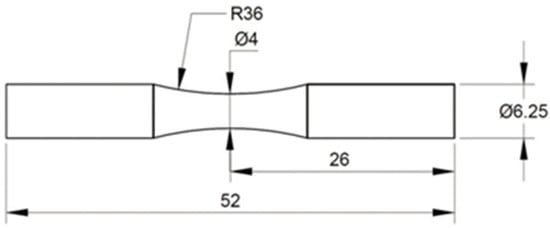
Figure 1
Open AccessArticle
Data-Driven Method for Predicting S-N Curve Based on Structurally Sensitive Fatigue Parameters
by
Andrey Kurkin, Alexander Khrobostov, Vyacheslav Andreev and Olga Andreeva
Metals 2025, 15(12), 1384; https://doi.org/10.3390/met15121384 - 17 Dec 2025
Abstract
Under cyclic loading, almost immediately after its onset, a surface layer forms where hardening and softening processes occur. The interaction of plastic deformation traces with each other, and with other structural elements, leads to the formation of a characteristic microstructure on the surface
[...] Read more.
Under cyclic loading, almost immediately after its onset, a surface layer forms where hardening and softening processes occur. The interaction of plastic deformation traces with each other, and with other structural elements, leads to the formation of a characteristic microstructure on the surface of a component subjected to cyclic loading. The set of factors (conditions) acting during cyclic loading determines the nature of slip band accumulation, the integral structurally sensitive fatigue parameter, expressed as the slope of the left side of the fatigue curve linearized in logarithmic coordinates, and the location of the breaking point on the fatigue curve in the high-cycle region. A combined review of numerous data on the fatigue of metals, obtained under various combinations of factors, and the generalization of these results through a normalization procedure for obtaining the relative (recalculated) parameters of fatigue, allows us to derive a universal method for “S-N” curve prediction. However, extensive generalization decreases the prediction accuracy for specific cases; therefore, it is proposed to form limited generalized dependencies corresponding to specific operating conditions. This paper evaluates the accuracy of fatigue limit prediction using generalized and limited-generalized relationships of fatigue recalculated parameters for various fatigue curves obtained from independent experimental data.
Full article
(This article belongs to the Special Issue Fatigue, Fracture, and Multiaxial Integrity of Metallic Structure Materials: From Microstructure to Data-Driven Assessment)
►▼
Show Figures
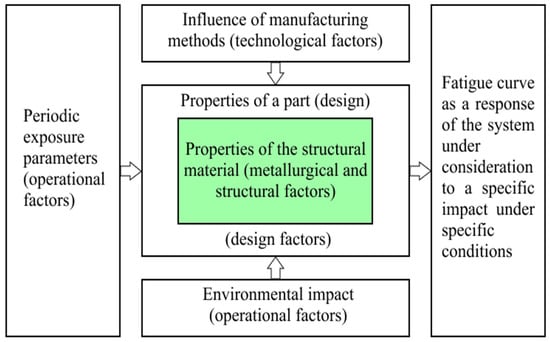
Figure 1
Open AccessReview
Research Progress on Application of Machine Learning in Continuous Casting
by
Zhaofeng Wang, Jinghao Shao, Shuai Zhang, Jiahui Zhang and Yuqi Pang
Metals 2025, 15(12), 1383; https://doi.org/10.3390/met15121383 - 17 Dec 2025
Abstract
►▼
Show Figures
Continuous casting is a key core link in steel production with characteristics of strong nonlinearity, multi-parameter coupling and dynamic fluctuations under working conditions. Traditional experience-dependent or mechanism-driven models are no longer suitable for the high-quality and high-efficiency production demands of modern steel industries.
[...] Read more.
Continuous casting is a key core link in steel production with characteristics of strong nonlinearity, multi-parameter coupling and dynamic fluctuations under working conditions. Traditional experience-dependent or mechanism-driven models are no longer suitable for the high-quality and high-efficiency production demands of modern steel industries. Machine learning provides an effective technical path for solving the complex control problems in the continuous casting process through its powerful data mining and pattern recognition capabilities. This paper systematically reviews the research progress of machine learning applications in the field of continuous casting, focusing on three core scenarios: abnormal prediction, quality defect detection and process parameter optimization. It sorts out the evolution from single models to feature optimization and integration, deep learning hybrid models, and mechanism-data dual-driven models. It summarizes the significant achievements of this technology in reducing production risks and improving the stability of cast billet quality, and it analyzes the prominent challenges currently faced such as data distortion and distribution imbalance, insufficient model interpretability and limited cross-scenario generalization ability. Finally, it looks forward to future technological innovation and application expansion directions, providing theoretical support and technical references for the digital and intelligent transformation of the steel industry.
Full article

Figure 1
Open AccessArticle
Ni-Driven Martensitic Packet Refinement to Improve the Low-Temperature Impact Toughness of Simulated CGHAZ in High-Strength Steel
by
Guodong Zhang, Zhongzhu Liu, Xuelin Wang, Lixia Li, Yuanyuan Li and Yanli Yang
Metals 2025, 15(12), 1382; https://doi.org/10.3390/met15121382 - 17 Dec 2025
Abstract
The effect of Ni content on the improvement of low-temperature impact toughness and microstructure refinement in a simulated coarse-grained heat-affected zone (CGHAZ) of high-strength steel was studied. The impact toughness tests revealed that as the heat input increased from 20 to 50 kJ/cm,
[...] Read more.
The effect of Ni content on the improvement of low-temperature impact toughness and microstructure refinement in a simulated coarse-grained heat-affected zone (CGHAZ) of high-strength steel was studied. The impact toughness tests revealed that as the heat input increased from 20 to 50 kJ/cm, both low-nickel (L-Ni) steel and high-nickel (H-Ni) steel exhibited a rapid decline in the impact toughness of their coarse-grained heat-affected zones (CGHAZ), though the H-Ni steel consistently demonstrated significantly higher impact toughness than the L-Ni steel. Microstructural characterization showed that the microstructure of L-Ni steel gradually transitioned from lath bainite (LB) to granular bainite (GB) with increasing heat input, which accounted for its reduced impact toughness. Conversely, H-Ni steel underwent a phase transformation from lath martensite (LM) to LB with increasing heat input, showing an unexpected trend opposite to the conventional understanding of toughness enhancement. Notably, the martensitic structure obtained in H-Ni steel at 20 kJ/cm exhibited substantially higher impact energy (59.6 J) than both the LB structures of L-Ni steel (44.6 J) and those of H-Ni steel (37.8 J) observed at 20 and 50 kJ/cm heat inputs. This phenomenon is attributed to the increased Ni content significantly refining the packet of LM, thereby enhancing its resistance to brittle crack propagation. Although LB structures obtained under different conditions exhibited refined blocks, their parallel arrangement within coarse packets resulted in less effective obstruction of brittle crack propagation compared to the refined packet with interlocking arrangement.
Full article
(This article belongs to the Special Issue Advances in Welding and Joining of Alloys and Steel)
►▼
Show Figures

Figure 1

Journal Menu
► ▼ Journal Menu-
- Metals Home
- Aims & Scope
- Editorial Board
- Reviewer Board
- Topical Advisory Panel
- Photography Exhibition
- Instructions for Authors
- Special Issues
- Topics
- Sections
- Article Processing Charge
- Indexing & Archiving
- Editor’s Choice Articles
- Most Cited & Viewed
- Journal Statistics
- Journal History
- Journal Awards
- Society Collaborations
- Conferences
- Editorial Office
Journal Browser
► ▼ Journal BrowserHighly Accessed Articles
Latest Books
E-Mail Alert
News
Topics
Topic in
Applied Sciences, Bioengineering, Coatings, Metals, JFB, Materials
Towards Load-Bearing Biomedical Titanium-Based Alloys: From Essential Requirements to Future Developments
Topic Editors: Liqiang Wang, Yanhua ChenDeadline: 31 December 2025
Topic in
JFB, Materials, Metals, Nanomanufacturing, Nanomaterials
Physical Methods for the Synthesis of Materials and Their Applications
Topic Editors: Vincenzo Amendola, Gregory GuisbiersDeadline: 31 March 2026
Topic in
Applied Sciences, Buildings, Construction Materials, CMD, Materials, Metals
Construction Materials: Corrosion, Prevention and Protection
Topic Editors: Sergio Lorenzi, Marco OrmelleseDeadline: 1 May 2026
Topic in
Analytica, Metals, Molecules, Processes, Separations
Advances in Solvent Extraction
Topic Editors: Guoquan Zhang, Weizao LiuDeadline: 31 May 2026

Conferences
Special Issues
Special Issue in
Metals
Advanced Ferroelectric Materials Doped with Rare Earth Metal Elements
Guest Editor: Bing XieDeadline: 25 December 2025
Special Issue in
Metals
Metal-Based Energy Materials and Systems: Mechanisms, Preparation, Characterization and Applications
Guest Editors: Wenqian Hao, Jiamiao Xie, Honggang Li, Genwei WangDeadline: 25 December 2025
Special Issue in
Metals
Metallic Materials Behaviour Under Applied Load
Guest Editors: Zhiping Xiong, Elena PerelomaDeadline: 30 December 2025
Special Issue in
Metals
Advances in Shape Memory Alloys: Theory, Experiment and Calculation
Guest Editors: Xiaoyang Yi, Gabriel A. LopezDeadline: 30 December 2025








